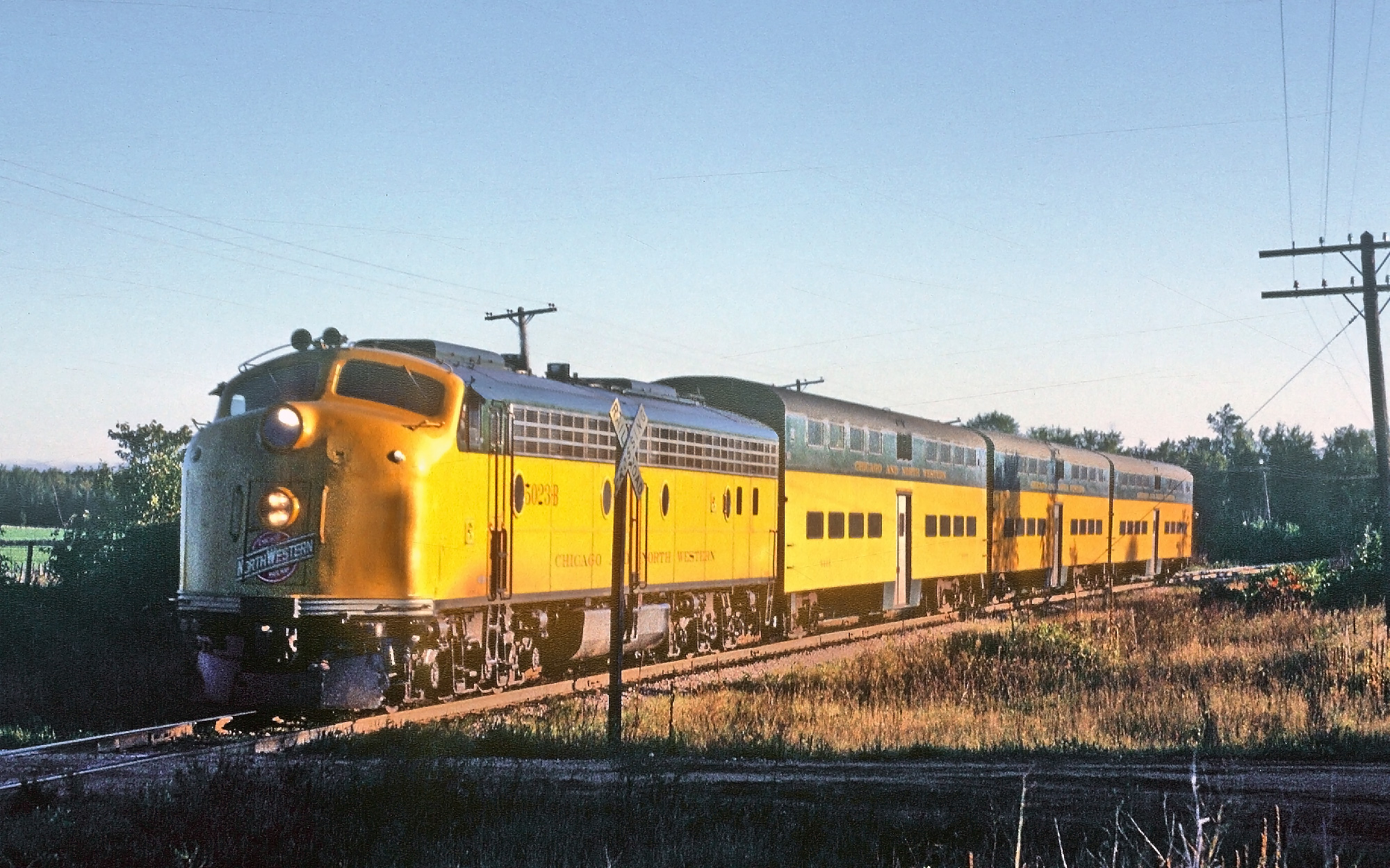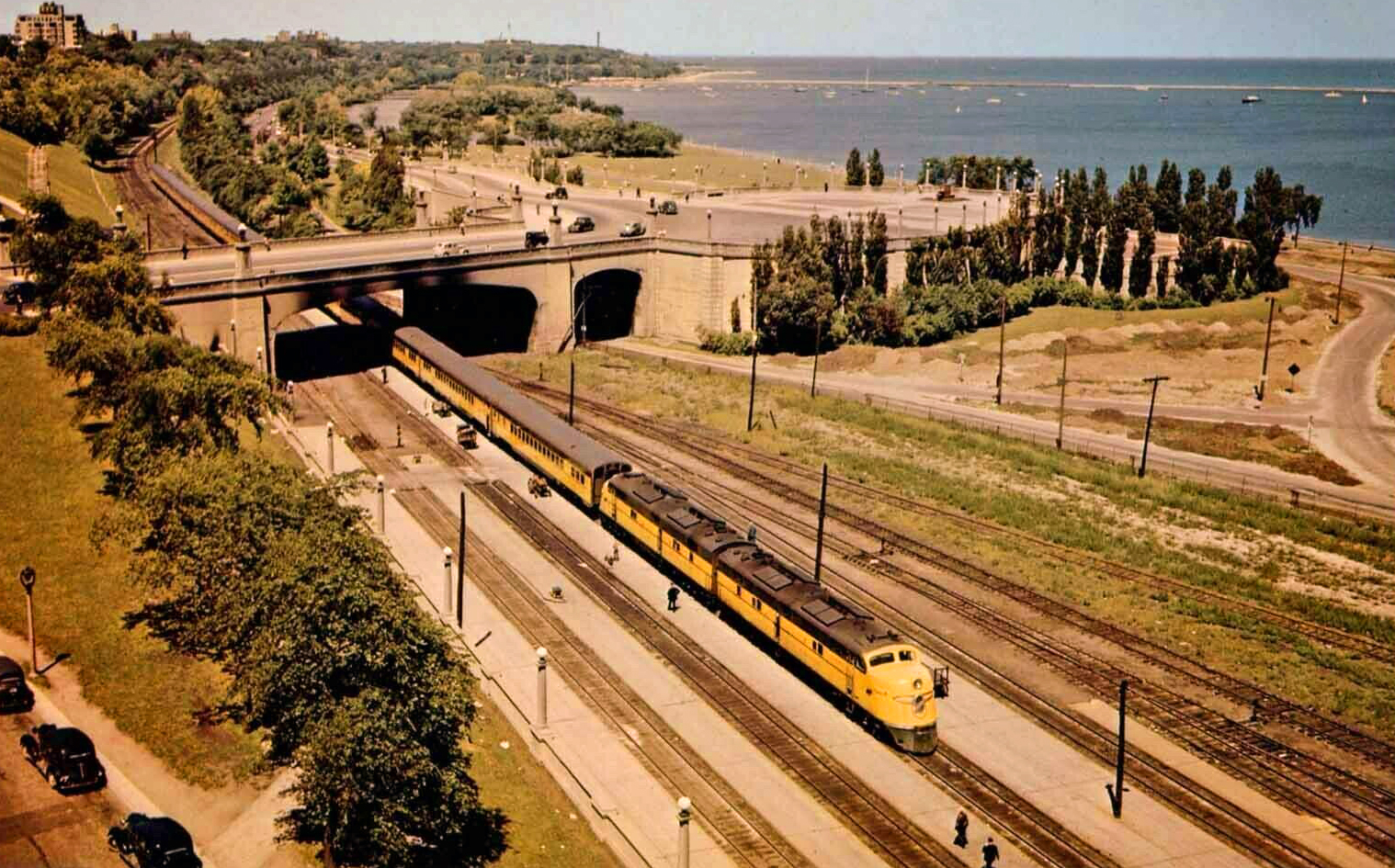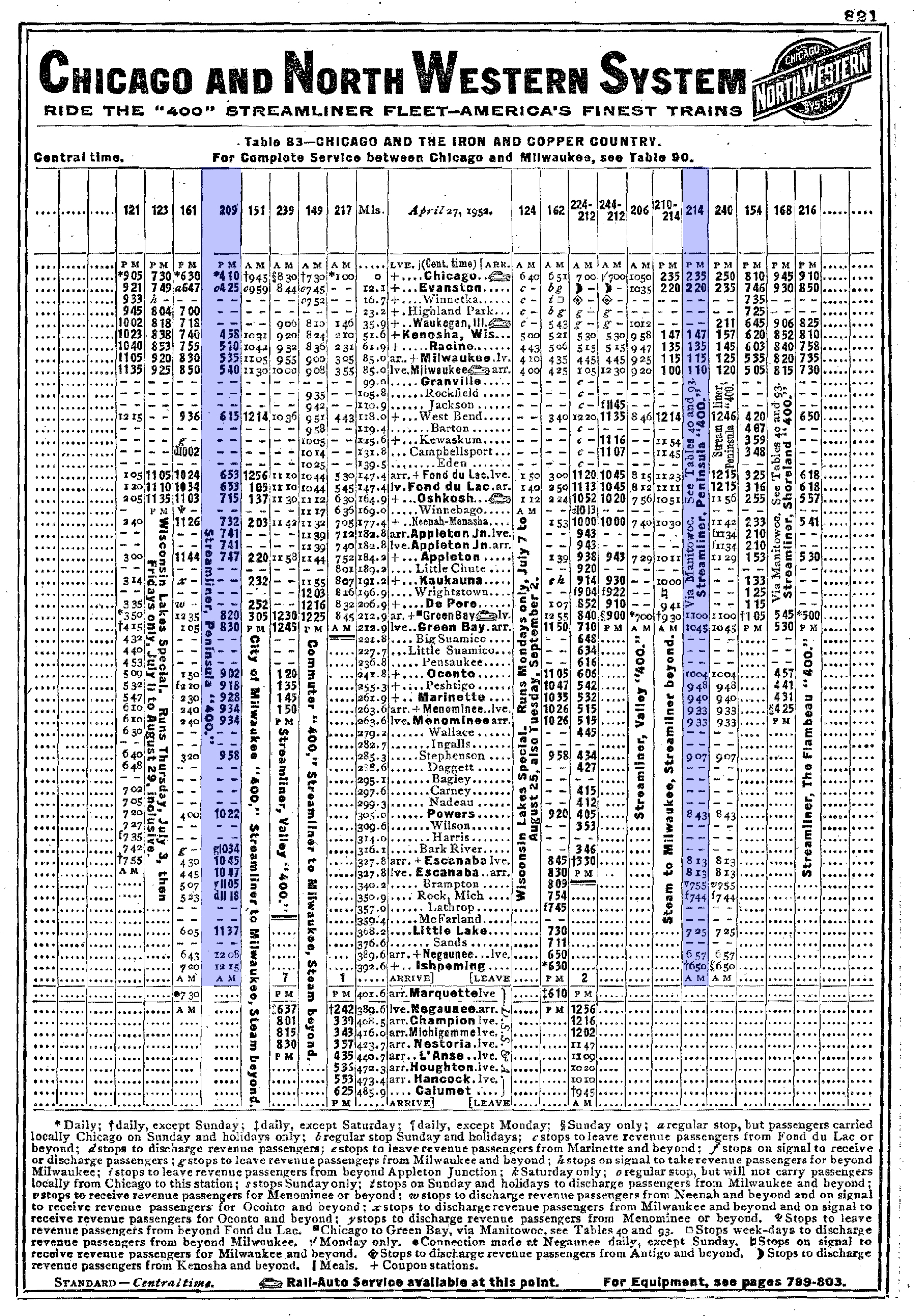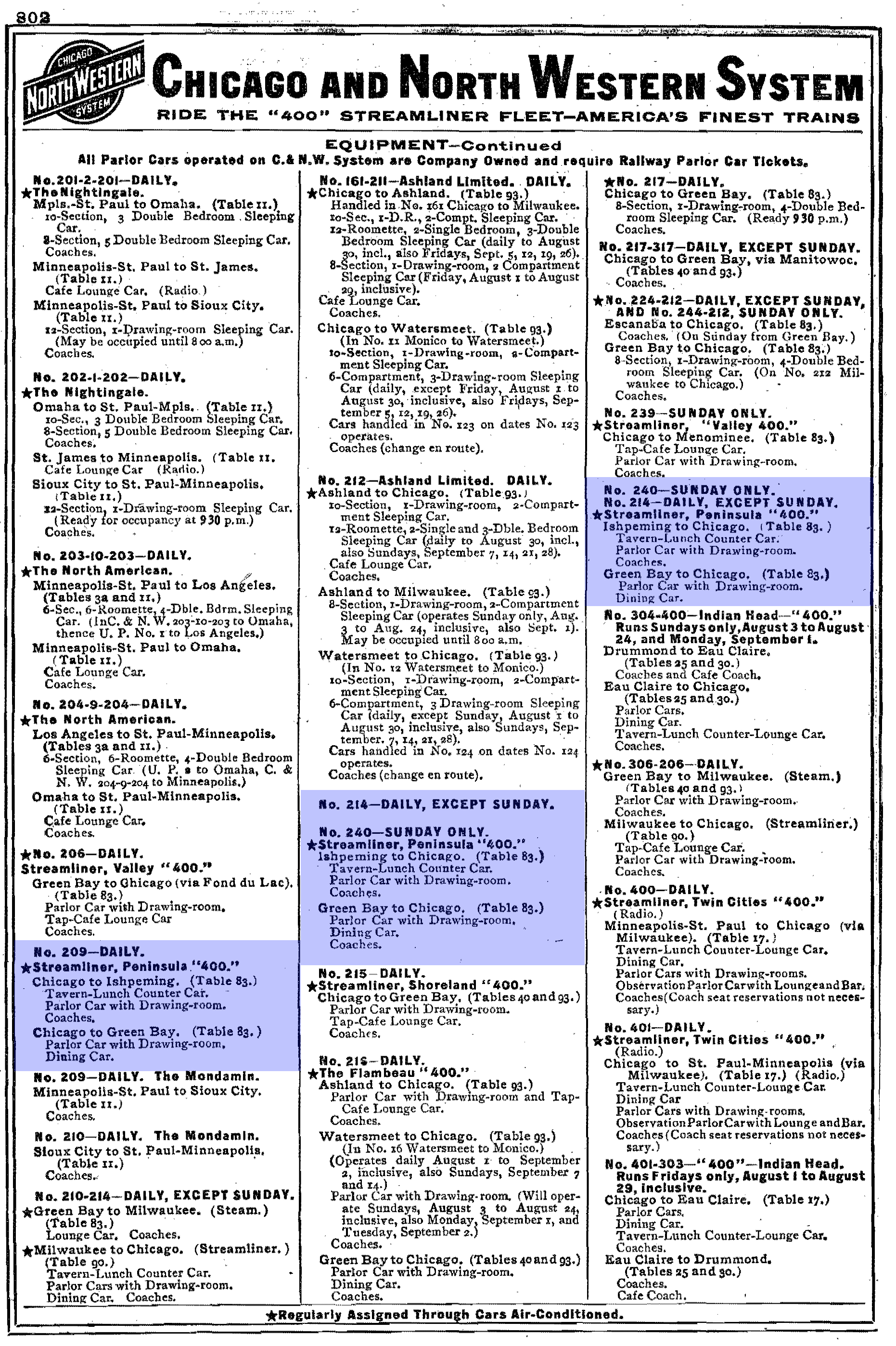The "Peninsula 400" : Chicago - Green Bay - Ishpeming
Last revised: September 15, 2024
By: Adam Burns
The Chicago & North Western found its original 400 serving Chicago and the Twin Cities a rousing success, even more so following the train's rechristening as a complete streamliner during 1939.
This led to the railroad launching an entire fleet of similarly named trains serving most of the railroad's system across the Midwest.
One of these was the Peninsula 400, introduced in the early 1940s when new diesels and lightweight equipment arrived.
The appropriately-named train served the U.P. of Michigan reaching the northern fringes of the railroad at Ishpeming although its most popular corridor was the densely populated region between Milwaukee, Chicago, and Green Bay.
As patronage declined during the 1950s the C&NW quietly dropped the train's name during the late 1960s although it continued on via a truncated routing.
Following the success of its initial 400 the 'North Western rushed to launch as many new versions of the original as it could.
This process began in January of 1942 when the first sets of lightweight equipment arrived from Pullman-Standard. According to Jim Scribbins in his book The 400 Story four new sets entered service at this time and closely mirrored the original of 1939.
In all, these trains included:
- Shoreland 400/Valley 400 between Chicago and Green Bay (albeit operating via separate routes between those two points)
- Capitol 400 between Chicago and Madison
- Peninsula 400 between Chicago and Ishpeming (Michigan) via Green Bay
- Commuter 400/City of Milwaukee 400 between Chicago and Milwaukee
Photos
 Chicago & North Western E8A #5023-B has the "Peninsula '400'" north of Oconto, Wisconsin in September, 1964. Roger Puta photo.
Chicago & North Western E8A #5023-B has the "Peninsula '400'" north of Oconto, Wisconsin in September, 1964. Roger Puta photo.History
The Peninsula was listed on C&NW's table as trains #209 northbound and #214 southbound.
According to Scribbins it wasn't long before this 400 surpassed the original in terms of patronage, becoming so popular that it wasn't uncommon to see 14 cars within the consist south of Green Bay and as a result was regularly assigned a pair of diesels to meet demand (the other 400s could normally do with a single head end unit).
The Peninsula, along with the rest of the 400s running at this time normally carried a tavern-lunch counter, diner, parlor, and at least four coaches (sometimes more, such as on the Peninsula, when demand required such).
Interestingly, unlike many other Midwestern roads the 'North Western never utilized domes on any of its trains, a feature that could have certainly drawn more patronage and lessened the blow of declining ridership during the 1950s.
One particularly interesting feature of the train, which had nothing to do with its on board services, was the motive power.
While the C&NW mostly stuck with Electro-Motive's beautiful E series diesels for its streamliners the company also acquired a single model DL-107 from the American Locomotive Company (Alco), #5007A, that was usually assigned to the Peninsula.
This locomotive was the builder's first cab series it ever cataloged in 1939 with a sleek look and long nose created by famed industrial designer Otto Kuhler.
It was the only cab model ever built to sport a unique three-piece front windshield and featured Alco's early model 539T prime mover.
Unfortunately, the troublesome engine proved the DL-107's downfall and few were sold among a handful of variants manufactured through the mid-1940s.
Aside from this unique locomotive the train could normally be found operating with Electro-Motive E3s or E6s during these early years and then later was pulled by E7s or E8s (and sometimes even an F7 during the late era prior to Amtrak).
 This panoramic view overlooking Lake Michigan features Chicago & North Western's southbound "Peninsula '400'," led by E3As, arriving at the Lake Front Depot in Milwaukee, Wisconsin during the early 1940s. C&NW publicity photo.
This panoramic view overlooking Lake Michigan features Chicago & North Western's southbound "Peninsula '400'," led by E3As, arriving at the Lake Front Depot in Milwaukee, Wisconsin during the early 1940s. C&NW publicity photo.During World War II the 'North Western experienced an incredible surge in passenger and freight traffic, which led the carrier to believe such volumes would continue after the conflict ended in 1945.
As a result the C&NW ordered more new equipment and according to Scribbins this included some twenty lightweight 400 coaches from Pullman-Standard during 1946 making it the first western road to receive new cars after the war (the New York Central had been the very first).
Timetable (1952)
Unfortunately for the entire industry, ridership waned after the conflict and hastened as the 1950s wore on. Late during that decade the C&NW began implementing cutbacks to help soften the losses.
One of the most notable ways it did this was through the introduction of bi-level, gallery cars that first entered service in 1958.
This equipment was manufactured by Pullman-Standard and through a deal with the state of Wisconsin enabled the C&NW to end 14 secondary trains that were becoming a significant liability on the balance sheets.
Timetable (April 29, 1962)
| Read Down Time/Leave (Train #209) | Milepost | Location | Read Up Time/Arrive (Train #214) |
|---|---|---|---|
| 3:10 PM (Dp) | 0.0 | 11:45 AM (Ar) | |
| 3:30 PM | 12.0 | 11:24 AM | |
| 3:55 PM | 35.9 | 11:01 AM | |
| 4:11 PM | 51.6 | 10:48 AM | |
| 4:23 PM | 61.9 | 10:36 AM | |
| 4:50 PM (Ar) | 84.4 | 10:10 AM (Dp) | |
| 4:55 PM (Dp/Via Fond du Lac) | 84.4 | 10:05 AM (Ar) | |
| 5:40 PM | 117.6 | ||
| 6:14 PM (Ar) | |||
| 6:19 PM (Dp) | |||
| 6:46 PM | 164.3 | ||
| 7:08 PM | 177.2 | ||
| 7:21 PM | 182.6 | ||
| 112.6 | 9:23 AM | ||
| 139.1 | 8:52 AM | ||
| 163.6 | 8:22 AM | ||
| 8:01 PM (Ar) | 200.4 | 7:40 AM (Dp/Via Manitowoc) |
The cars were similar to the commuter coaches the railroad would use in suburban Chicago service but offered upgraded features such as diners, parlors, baggage-taverns, and reclining seat coaches.
Consist (1952)
Scribbins states that some were used on the Peninsula 400 which included coaches, a coach-bar, and a standard parlor. The C&NW went to great lengths to advertise the new cars in promotional material.
For instance, one such piece stated:
"More individual seat space per passenger. Coach seats on both levels are 'comfort-engineered' for easy riding and provide greater space than conventional seats. Single as well as double seating is provided.
Parlor cars with upper and lower 'See-Levels.' Elegant spaciousness keynotes the parlor car with its individual all-position easy chairs. Here you can enjoy the passing scene in quiet comfort from either level."
"Two-level luxury lounge service. Toast your fellow travelers in the country club atmosphere of the be-level Bar-Lounge. Built-in fixtures in the arm of each chair provide a self sufficient serving place for single seats. Table accommodations are available for groups of two or four.
Spacious, sparkling dining cars. A planned effect of openness and colorful room decor makes dining on these trains a festive event. Here a varied menu of freshly prepared meals coupled with courteous service may be enjoyed as your train moves swiftly to its destination."
Final Years
In the end, however, nothing could curtail the growing losses as passengers left the rails for highways and airlines. Scribbins notes that during mid-July of 1969 the C&NW discontinued the Peninsula 400 north of Green Bay and subsequently dropped the 400 title on its remaining trains.
Recent Articles
-
California Valentine's Train Rides
Jan 17, 26 09:47 AM
Operating out of West Sacramento, this excursion railroad has built a calendar that blends scenery with experiences—wine pours, themed parties, dinner-and-entertainment outings, and seasonal specials… -
South Carolina Dinner Train Rides
Jan 16, 26 11:13 PM
There is only location in the Palmetto State offering a true dinner train experience can be found at the South Carolina Railroad Museum. Learn more here. -
Rhode Island Dinner Train Rides
Jan 16, 26 11:01 PM
Despite its small size, Rhode Island is home to one popular dinner train experience where guests can enjoy the breathtaking views of Aquidneck Island. -
Pennsylvania's Thomas The Train Rides
Jan 16, 26 04:13 PM
"A Day Out With Thomas” train rides offer a unique opportunity for children and their families to engage in a magical and memorable experience, setting the stage for a full day of fun and adventure. -
Illinois's Thomas The Train Rides
Jan 16, 26 02:23 PM
In Illinois, the "A Day Out With Thomas" event offers a unique chance for families to immerse themselves in the enchanting world of Thomas and friends, creating memories that last a lifetime. -
New Jersey's Thomas The Train Rides
Jan 16, 26 02:11 PM
Here's a comprehensive guide to what you can expect at Day Out With Thomas events in New Jersey. -
Texas ~ Murder Mystery ~ Dinner Train Rides
Jan 16, 26 01:54 PM
Here’s a comprehensive look into the world of murder mystery dinner trains in Texas. -
Connecticut ~ Murder Mystery ~ Dinner Train Rides
Jan 16, 26 01:26 PM
All aboard the intrigue express! One location in Connecticut typically offers a unique and thrilling experience for both locals and visitors alike, murder mystery trains. -
New Hampshire Dinner Train Rides In N. Conway!
Jan 16, 26 10:47 AM
Tucked into the heart of New Hampshire’s Mount Washington Valley, the Conway Scenic Railroad is one of New England’s most beloved heritage railways -
Oregon Dinner Train Rides Near Mt. Hood!
Jan 16, 26 10:44 AM
The Mt. Hood Railroad is the moving part of that postcard—a century-old short line that began as a working railroad. -
Maryland's - Wine Tasting - Train Rides
Jan 15, 26 02:59 PM
This article delves into the enchanting world of wine tasting train experiences in Maryland, providing a detailed exploration of their offerings, history, and allure. -
Colorado's - Wine Tasting - Train Rides
Jan 15, 26 02:46 PM
To truly savor these local flavors while soaking in the scenic beauty of Colorado, the concept of wine tasting trains has emerged, offering both locals and tourists a luxurious and immersive indulgenc… -
Iowa ~ Wine Tasting ~ Train Rides
Jan 15, 26 02:36 PM
The state not only boasts a burgeoning wine industry but also offers unique experiences such as wine by rail aboard the Boone & Scenic Valley Railroad. -
Georgia's Wine Train Rides In Cordele!
Jan 15, 26 02:26 PM
While the railroad offers a range of themed trips throughout the year, one of its most crowd-pleasing special events is the Wine & Cheese Train—a short, scenic round trip designed to feel like a t… -
Indiana ~ Murder Mystery ~ Dinner Train Rides
Jan 15, 26 02:22 PM
This piece explores the allure of murder mystery trains and why they are becoming a must-try experience for enthusiasts and casual travelers alike. -
Ohio ~ Murder Mystery ~ Dinner Train Rides
Jan 15, 26 02:10 PM
The murder mystery dinner train rides in Ohio provide an immersive experience that combines fine dining, an engaging narrative, and the beauty of Ohio's landscapes. -
Nevada Dinner Train Rides In Ely!
Jan 15, 26 02:01 PM
If you’ve ever wished you could step through a time portal into the hard-working world of a 1900s short line the Nevada Northern Railway in Ely is about as close as it gets. -
Michigan Dinner Train Rides In Owosso!
Jan 15, 26 09:46 AM
The Steam Railroading Institute is best known as the home of Pere Marquette #1225 and even occasionally hosts a dinner train! -
Arizona's - Wine Tasting - Train Rides
Jan 14, 26 02:04 PM
For those who want to experience the charm of Arizona's wine scene while embracing the romance of rail travel, wine tasting train rides offer a memorable journey through the state's picturesque landsc… -
Arkansas's - Wine Tasting - Train Rides
Jan 14, 26 01:57 PM
This article takes you through the experience of wine tasting train rides in Arkansas, highlighting their offerings, routes, and the delightful blend of history, scenery, and flavor that makes them so… -
Tennessee ~ Murder Mystery ~ Dinner Train Rides
Jan 14, 26 01:42 PM
Amidst the rolling hills and scenic landscapes of Tennessee, an exhilarating and interactive experience awaits those with a taste for mystery and intrigue. -
California ~ Murder Mystery ~ Dinner Train Rides
Jan 14, 26 01:26 PM
When it comes to experiencing the allure of crime-solving sprinkled with delicious dining, California's murder mystery dinner train rides have carved a niche for themselves among both locals and touri… -
Illinois ~ Murder Mystery ~ Dinner Train Rides
Jan 14, 26 01:13 PM
Among Illinois's scenic train rides, one of the most unique and captivating experiences is the murder mystery excursion. -
Vermont's - Murder Mystery - Dinner Train Rides
Jan 14, 26 12:57 PM
There are currently murder mystery dinner trains offered in Vermont but until recently the Champlain Valley Dinner Train offered such a trip! -
Massachusetts Dinner Train Rides On Cape Cod!
Jan 14, 26 12:20 PM
The Cape Cod Central Railroad (CCCR) has carved out a special niche by pairing classic New England scenery with old-school hospitality, including some of the best-known dining train experiences in the… -
Maine Dinner Train Rides In Portland!
Jan 14, 26 11:31 AM
While this isn’t generally a “dinner train” railroad in the traditional sense—no multi-course meal served en route—Maine Narrow Gauge does offer several popular ride experiences where food and drink a… -
Kentucky Dinner Train Rides In Bardstown!
Jan 13, 26 01:14 PM
The essence of My Old Kentucky Dinner Train is part restaurant, part scenic excursion, and part living piece of Kentucky rail history. -
Kansas Dinner Train Rides In Abilene!
Jan 13, 26 12:44 PM
If you’re looking for a heritage railroad that feels authentically Kansas—equal parts prairie scenery, small-town history, and hands-on railroading—the Abilene & Smoky Valley Railroad (A&SV) delivers. -
Michigan ~ Murder Mystery ~ Dinner Train Rides
Jan 13, 26 11:24 AM
Among the lesser-known treasures of this state are the intriguing murder mystery dinner train rides—a perfect blend of suspense, dining, and scenic exploration. -
Virginia's - Murder Mystery - Dinner Train Rides
Jan 13, 26 11:11 AM
Among the state's railroad attractions, murder mystery dinner trains stand out as a captivating fusion of theatrical entertainment, fine dining, and scenic travel. -
Arizona Dinner Train Rides At The Grand Canyon!
Jan 13, 26 10:59 AM
While the Grand Canyon Railway does not offer a true, onboard dinner train experience it does offer several upscale options and off-train dining. -
Georgia Dinner Train Rides In Nashville!
Jan 13, 26 10:27 AM
If you’ve ever wished you could slow down, trade traffic for jointed rail, and let a small-town landscape roll by your window while a hot meal is served at your table, the Azalea Sprinter delivers tha… -
Indiana Valentine's Train Rides
Jan 12, 26 04:27 PM
If you’ve ever wished you could step into a time when passenger trains were a Saturday-night treat and a whistle echoing across farm fields meant “adventure,” the Nickel Plate Express delivers that fe… -
Ohio Valentine's Train Rides!
Jan 12, 26 04:20 PM
The Hocking Valley Scenic Railway offers one of the region’s most atmospheric ways to experience the Hocking Hills area: from the rhythmic click of jointed rail to the glow of vintage coaches rolling… -
Wisconsin's - Wine Tasting - Train Rides
Jan 12, 26 03:10 PM
Wisconsin might not be the first state that comes to mind when one thinks of wine, but this scenic region is increasingly gaining recognition for its unique offerings in viticulture. -
California's - Wine Tasting - Train Rides
Jan 12, 26 02:34 PM
This article explores the charm, routes, and offerings of these unique wine tasting trains that traverse California’s picturesque landscapes. -
Wisconsin Scenic Train Rides In North Freedom!
Jan 12, 26 02:20 PM
The Mid-Continent Railway Museum is a living-history museum built around the sights, sounds, and everyday rhythms of small-town and shortline railroading in the early 20th century, what the museum cal… -
Vermont Scenic Train Rides In Burlington!
Jan 12, 26 01:18 PM
Today, GMRC is best known by many travelers for its Burlington-based passenger experiences—most famously the Champlain Valley Dinner Train and the sleek, limited-capacity Cocktails on the Rails. -
Maryland's - Murder Mystery - Dinner Train Rides
Jan 12, 26 01:03 PM
Maryland is known for its scenic landscapes, historical landmarks, and vibrant culture, but did you know that it’s also home to some of the most thrilling murder mystery dinner trains? -
Minnesota's - Murder Mystery - Dinner Train Rides
Jan 12, 26 12:17 PM
Murder mystery dinner trains offer an enticing blend of suspense, culinary delight, and perpetual motion, where passengers become both detectives and dining companions on an unforgettable journey. -
Vermont Dinner Train Rides In Burlington!
Jan 12, 26 12:09 PM
There is one location in Vermont hosting a dedicated dinner train experience at the Green Mountain Railroad. -
Connecticut Dinner Train Rides In Essex!
Jan 12, 26 10:39 AM
Connecticut's rail heritage can be traced back to the industry's earliest days and a few organizations preserve this rich history by offering train rides. The Essex Steam Train also hosts dinner-theme… -
Florida Scenic Train Rides In Parrish!
Jan 11, 26 10:26 PM
The Florida Railroad Museum (FRRM) in Parrish offers something increasingly rare in today’s rail landscape: a chance to ride historic equipment over a surviving fragment of an early-20th-century mainl… -
California's - Wine Tasting - Train Rides
Jan 11, 26 02:28 PM
This article explores the charm, routes, and offerings of these unique wine tasting trains that traverse California’s picturesque landscapes. -
Georgia's - Murder Mystery - Dinner Train Rides
Jan 11, 26 02:07 PM
In the heart of the Peach State, a unique form of entertainment combines the thrill of a murder mystery with the charm of a historic train ride. -
Colorado ~ Murder Mystery ~ Dinner Train Rides
Jan 11, 26 01:43 PM
Nestled among the breathtaking vistas and rugged terrains of Colorado lies a unique fusion of theater, gastronomy, and travel—a murder mystery dinner train ride. -
Minnesota Dinner Train Rides In Duluth!
Jan 11, 26 01:32 PM
One of the best ways to feel the region's history in motion today is aboard the North Shore Scenic Railroad (NSSR), which operates out of Duluth’s historic depot. -
Illinois Dinner Train Rides At Monticello!
Jan 11, 26 12:42 PM
The Monticello Railway Museum (MRM) is one of those places that quietly does a lot: it preserves a sizable collection, maintains its own operating railroad, and—most importantly for visitors—puts hist… -
Alabama's - Wine Tasting - Train Rides
Jan 10, 26 09:29 AM
While the state might not be the first to come to mind when one thinks of wine or train travel, the unique concept of wine tasting trains adds a refreshing twist to the Alabama tourism scene. -
Maryland Dinner Train Rides At WMSR!
Jan 10, 26 09:13 AM
The Western Maryland Scenic Railroad (WMSR) has become one of the Mid-Atlantic’s signature heritage operations—equal parts mountain railroad, living museum, and “special-occasion” night out.

















































